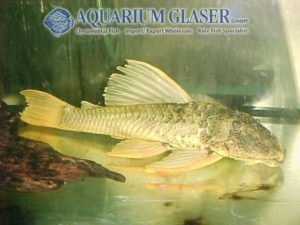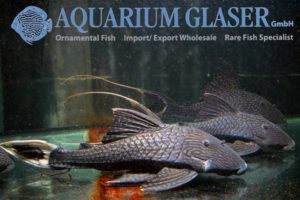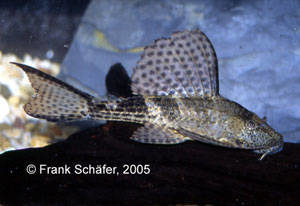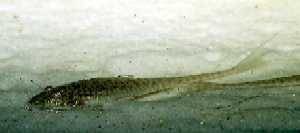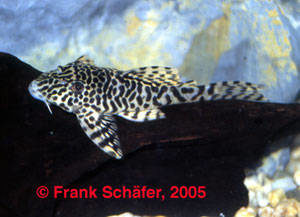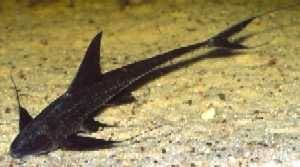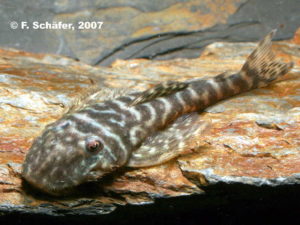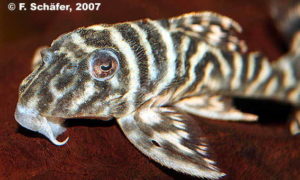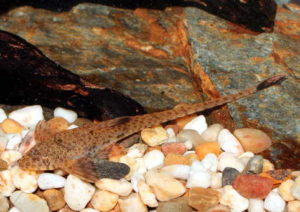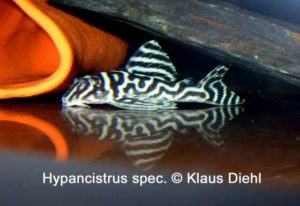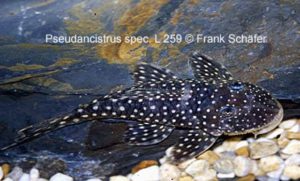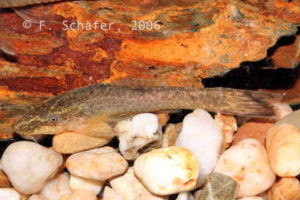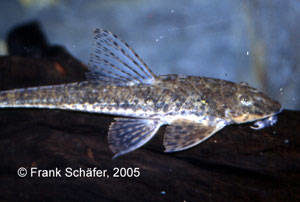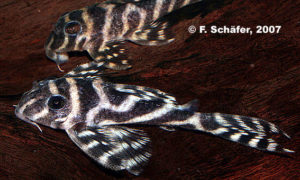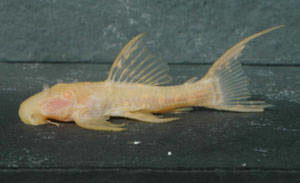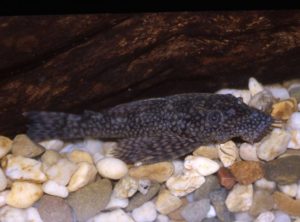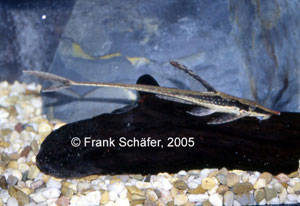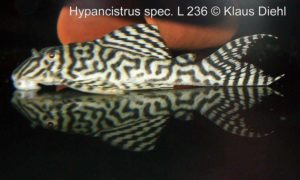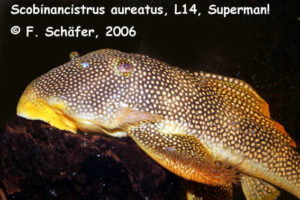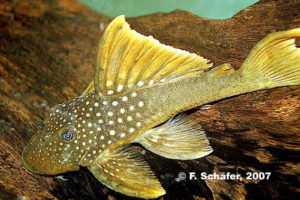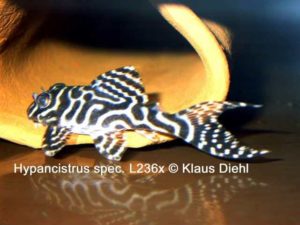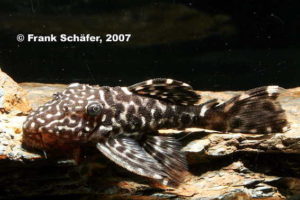From southern Brazil and northern Argentina originates the probably most beautiful representative of the genus Hypostomus. Contrary to many other loricariids they become more beautiful with increasing age, since the portion of the yellow body parts constantly increases. Their southern area of origin suggests a tolerance in relation to low temperatures. They can be can […]
10b. Catfishes: Suckermouths, Plecos and L-numbers (323)
-
-
Panaque spec. „Papa Ojo Chico“ L 90a
With L 90a we can offer at present one of the most beautiful Panaque species. Especially the extremely long, orange colored filaments of the caudal fin are remarkable. In addition, the discrete black markings on the noble-grey colored body let them appear very elegant. With the purchase of these fishes their final size (over 30cm) […]
-
Hypostomus sp. „Chaco“
A close relative of the well known common plecos, is shown at the time of the importation not fully grown yet. This fish can easily grow up to 30 cm in length. This pleco is a harmless solitude fish, very well suited for the cichlid aquarium. It is an animal who has a nocturnal way […]
-
Pseudohemiodon thorectes
This catfish coming from Bolivia, belongs to the smallest of his relatives, measuring 13 cm maximum. It is mostly getting imported by travelling aquarium hobbyists. Regarding the water condition this kind is rather adaptable, as guide values of up to 400 µS/cm and a pH-value of 7.6 were measured. Approx. 25°C are quite enough for […]
-
Peckoltia. spec. L 134
From the Rio Jamanxim (Brazil) comes one of the most attractive members of the genus Peckoltia. L 134 is very variably marked: as well as individuals with stripes there are also specimens with large round spots on the body. It is not known whether this difference in colouration denotes sex, but in at least one […]
-
Pterosturiosoma microps
Pterosturiosoma microps is one of the regularly imported Loricariidae from Peru, although not in bigger quantities. Even though it is more impressing in colour by its soft black-grey, it can still arouse enthusiasm by its remarkable appearance and its impressive but graceful fins. But its steady nursing is not quite easy. Whereas the acclimatization probably […]
-
Ancistrinae spec. L 189
Several adult specimen of L 189 the wormline – Orinko catfish arrived with an import of L 257 Pseudolithoxus tigris. On this shown male, the odontodes on the head, breast and ventral fin are clearly visible, that absolutely states a belonging in the Pseudolithoxus group. Puberty is approximately reached at 7 cm, it’s end size […]
-
Hypancistrus spec. Xingu
From lower parts of the Rio Xingu we received very high-contrasted Hypancistrus spec. Xingu. In their appearance they arrange between L 333 and fishes of the L 66 group. But they are clearly more flattened and stretched than L 333. From L 66 and their relatives (e.g. L 236) they can be distinguished by the […]
-
Rineloricaria melini
As a further german bred rarity we can offer Rineloricaria melini at present. Our specimen of the probably most attractive Rineloricaria species have with 9 – 12 cm length already attained full growth and are of outstanding quality. Their origin is the area of the Rio Negro where they live in black water biotopes. Like […]
-
Hypancistrus spec. L 173
March 2005: Freshly arrived: Beautiful German breds of L 173. For the first time we can offer thereby more than a “handful” of these wonderful rare pieces. The large variability of their pattern is remarkable. The bluish glow is common in all the white of their fins. (Photo & Text K. Diehl)
-
Pseudancistrus spec. L 259
Pseudancistrus spec. L 259 originates from the surrounding of the city Pimental at the Rio Tapajos. As all Pseudancistrus species the males of L 259 show a characteristic “beard” of Odontodes (dermal teeth) during the spawning season. Contrary to the popular Hypancistrus species L 259 are vegetarians. Therefore Zucchini, cucumbers and further vegetables should be […]
-
Hisonotus notatus
July 2006 From southeast Brazil we could import some rare pieces from the relationship of the popular Otocinclus species. In its homeland Hisonotus ornatus inhabits with weeds infested waters. It may not be kept too warm. 24°C probably represents the reasonable upper limit. The requirements for their maintenance do not differ from those of the […]
-
Rineloricaria sp. „Colombia“
A remarkable species which came in in one of our import from Colombia. These fishes also originate from the Rio Chacu in the northern tip of the country. Because of the many bristles of the male this species has been falsely determined as Rineloricaria latirostris. A comparison with the pictures (see Mergus Catfish Atlas Part […]
-
Hypancistrus spec. L 173 Bred
March 2007: Freshly arrived: Beautiful German breds of L 173. For the first time we can offer thereby more than a “handful” of these wonderful rare pieces. The large variability of their pattern is remarkable. The bluish glow is common in all the white of their fins. (Photo F. Schäfer, Text K. Diehl)
-
Pseudoacanthicus spec. „Albino Titanic“ L 273
April 2005: Only one fish of the albino form of the well-known „Titanic Catfish“ was imported from Belem (Brazil). L 273 is normally extremely variably coloured from fish to fish. As well as splendid specimens with contrasting dark grey/yellow plus orange colouration there are also individuals that are predominantly mouse grey with black dots and […]
-
Ancistrus spec. L 111
This ancistrus, which supposedly originates from Colombia, exhibits similarities to L 89, but like L 156 has round spots arranged in a honeycomb pattern. Unlike these other two L-numbers, L 111 has a uniformly marked iris ring and light/dark grey striped pectoral fin spines. This catfish is said to grow to about 10 cm, and […]
-
Sturisoma sp. „Colombia“
This for science unknown species was imported with a unique shipment from Colombia. Sturisoma sp. „Colombia“ was found in the Rio Chaco in the North of Colombia. This elegant Sturisoma species differs from the short finned species, which live on sandy habitats as well as from Sturisoma festivum by difference in colouration and body form. […]
-
Ancistrus spec. L 352
Our photo shows a pair of Ancistrus spec. L 352, one with 6 – 7 cm very small remaining loricariid from the Rio Iriri. In the view from above the different body forms can easily be be recognized. This and the characteristic beard of the males makes a differentiating of the sexes quite easy. As […]
-
Hypancistrus spec. L 236
„Simply the Best “: Some days ago we could import some of this beauties. With a size of approx. 10cm the white of the here illustrated male shows a fantastic intensity. It seems that one of imported fishes is a not less beautiful female, and so we hope to be able to offer some days […]
-
Scobiancistrus aureatus L 14
December 2006: Last week received we a really impressive, male Scobiancistrus aureatus. With a length of about 30 cm it might be attained full growth. The strong spines on the gill cover (Interopercularodontodes), as well as on their pectoral fins are remarkable. As most L-catfishes from the Rio Xingu they like warmer waters, for their […]
-
Baryancistrus demantoides L 200 High Fin
From Colombia we could import expressed beautiful L 200 High Fin. Now we have very attractive partially completely yellow colored specimen of the species Baryancistrus demantoides in stock. They will get only about 15 cm long and remain thereby substantially smaller than the also with the number L the 200 labeled Hemiancistrus subviridis. Compared with […]
-
Hypancistrus spec. L 236x
November 2006: At Christmas we would like to present a star at the catfish heaven. We can offer some offspring of the queen imperial zebra Hypancistrus spec. L 236x, a beautiful and very looked for species. They come from a German breeder, who had the luck that the two from us imported animals formed a […]
-
Leporacanthicus sp. „NEW“
April 2007: We received a particularly beautiful easter surprise this week from Colombia. The representative of the genus Leporacanthicus illustrated here is probably the first and only specimen on the market. It reminds of the in the Orinoco occurring L 240 and L 241, as well as of Leporacanthicus cf. “Venezuela”. But its white spots […]





